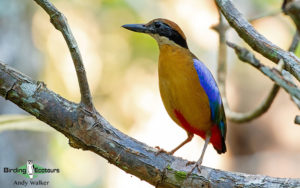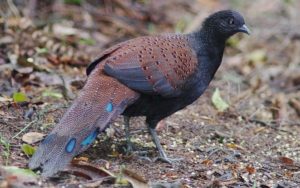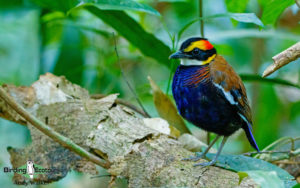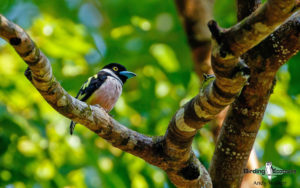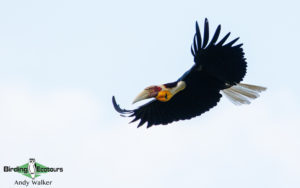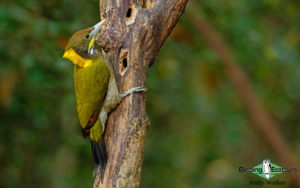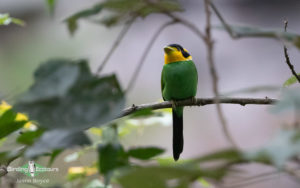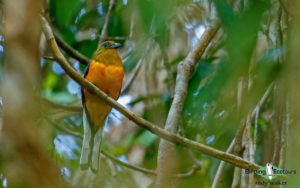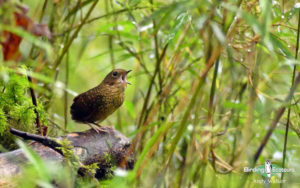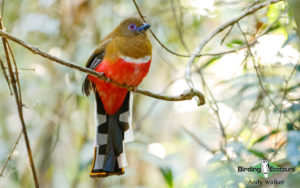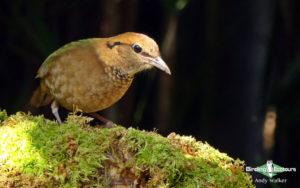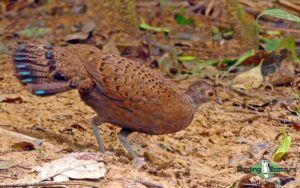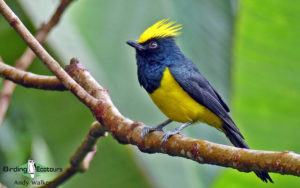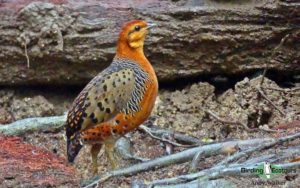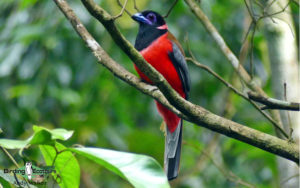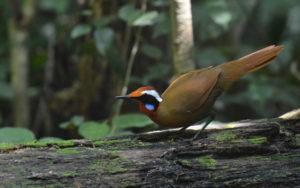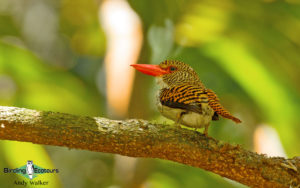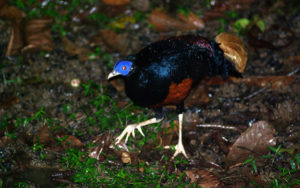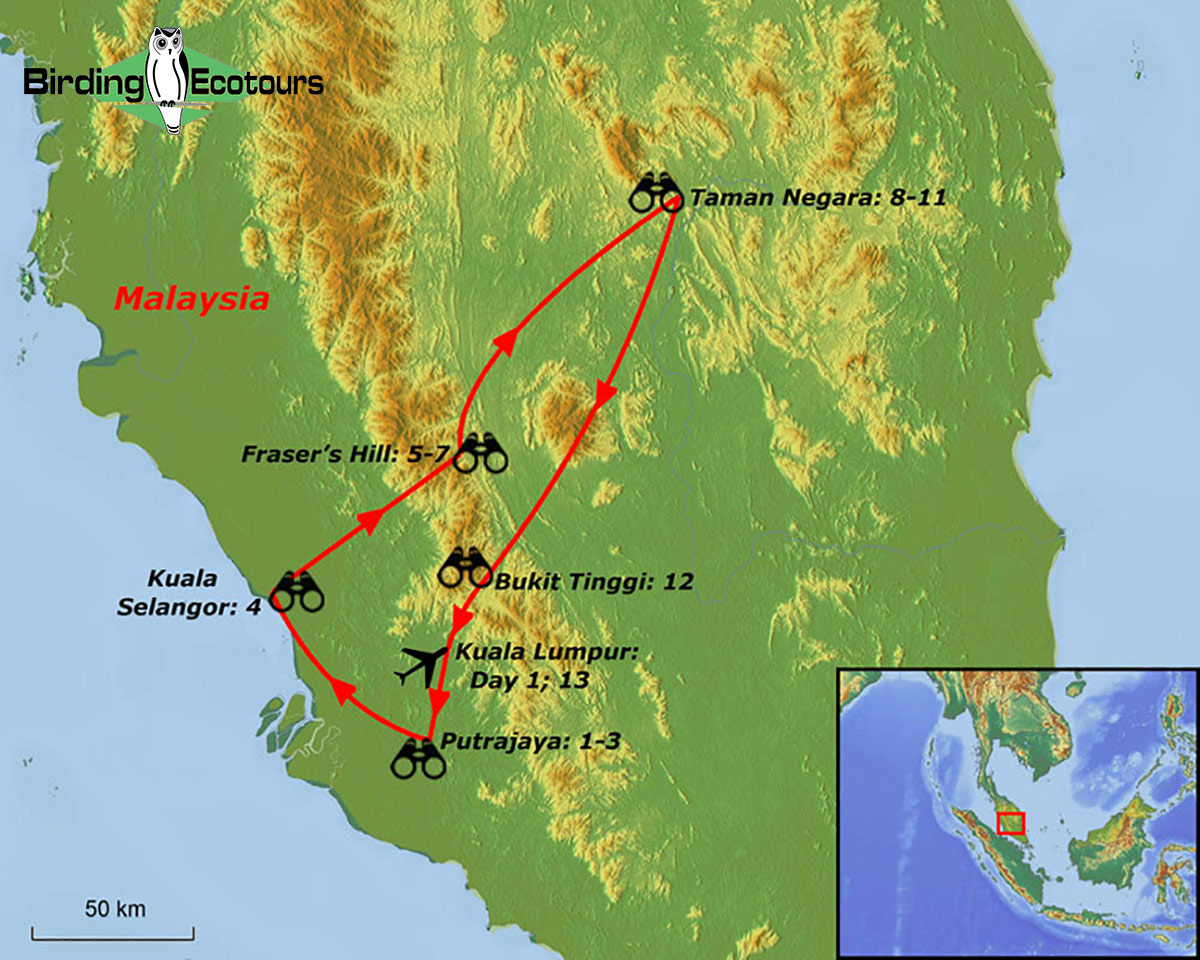Birding Tour Malaysia: Peninsular Malaysia
Go to: Malaysia Birding Tours | Borneo Birding Tours | Birding Tours in Asia | All our birding tours
Peninsular Malaysia
September 2025
One of the most biodiverse countries in the world, Malaysia is a federation of 13 states across two regions. One region is West Malaysia (Peninsular Malaysia, and the focus of this small group birdwatching tour) and the other region is East Malaysia (which includes Sabah and Sarawak on the island of Borneo, where we have two very exciting tours that run immediately before this tour, details below).
Peninsular Malaysia sits at the foot of the longer Malay Peninsula, the backbone of which, the Titiwangsa Range, is draped in pristine montane forest with the lowlands carpeted in extensive tropical rainforest melting into vast mangrove forests along the coast. The combination of this results in some of the most exciting birdwatching in Southeast Asia.
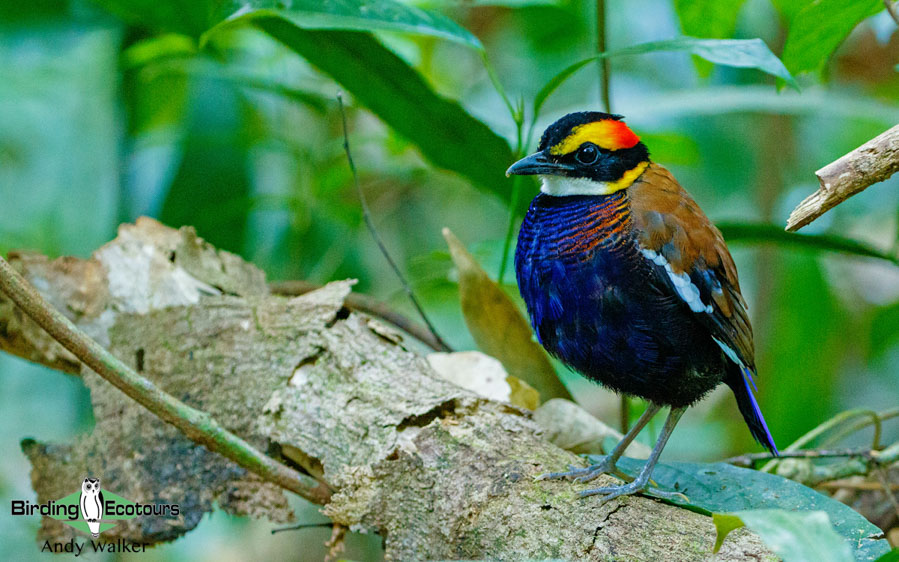 Malayan Banded Pitta is one of our vibrant target birds on this trip.
Malayan Banded Pitta is one of our vibrant target birds on this trip.
This tour will cover several key birding sites in peninsular Malaysia, starting in the coastal mangrove forests at Kuala Selangor, moving to the highlands and the marvelous Fraser’s Hill and then continuing to one of the best areas for birdwatching in all of Malaysia (and possibly even Southeast Asia), the world-famous and stunningly bird-rich Taman Negara National Park; the tropical rainforest here is said to be over 130 million years old, and we will find some spectacular wildlife during our time here. We will finish our tour back in the mountains with a visit to Bukit Tinggi, home of one of our endemic targets. This circuit of peninsular Malaysia is well-tried and tested by us and always comes up with some great birds.
We will be targeting many of the highly sought charismatic species to be found in peninsular Malaysia, such as pittas, trogons, broadbills, hornbills, pheasants, and kingfishers, along with some very special, secretive birds such as the monotypic Rail-babbler, the endemic Malayan Whistling Thrush and Mountain Peacock-Pheasant, and the near-endemic Malayan Peacock-Pheasant, Malayan Laughingthrush, and Malayan Partridge.
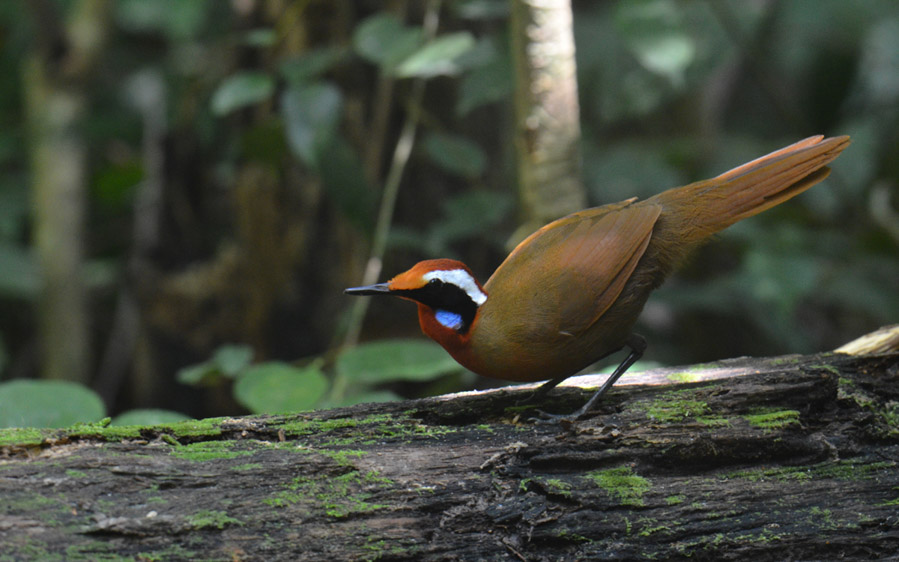
There are many other high-quality birds possible on the tour, such as Rhinoceros Hornbill, Black Hornbill, and Helmeted Hornbill (three of the ten hornbill species possible), Black-and-yellow Broadbill, Long-tailed Broadbill, and Green Broadbill (three of the seven broadbill species possible), and Diard’s Trogon, Scarlet-rumped Trogon, and Red-headed Trogon (three of the six trogon species possible). Night birds are well represented too, with Large Frogmouth, Gould’s Frogmouth, Blyth’s Frogmouth, Malaysian Eared Nightjar, Oriental Bay Owl, Buffy Fish Owl, Reddish Scops Owl, White-fronted Scops Owl, Brown Wood Owl, Eastern Barn Owl, and Grey Nightjar a few of the very enticing possibilities.
If that is not enough to whet your appetite, what about this who’s who of simply spectacular birds that we could find: Ferruginous Partridge, Great Argus, Crested Partridge, Crested Fireback, Garnet Pitta, Blue-winged Pitta, Hooded Pitta, Mangrove Pitta, Malayan Banded Pitta, Rusty-naped Pitta, Banded Kingfisher, Rufous-collared Kingfisher, Whiskered Treeswift, Great Slaty Woodpecker, Common Green Magpie, Chestnut-naped Forktail, Silver-eared Mesia, Long-tailed Sibia, Straw-headed Bulbul, Mangrove Blue Flycatcher, Malaysian Blue Flycatcher, Large Wren-Babbler, and so many more!
This tour can be combined with our Birding Tour Borneo: Sabah Classic Tour and Birding Tour Borneo: Sarawak – Restricted Range Endemics; both have been designed to complement this Peninsular Malaysia tour and focus on the multitude of endemic birds that can be found on the island of Borneo, such as the following mouthwatering selection: Whitehead’s Trogon, Whitehead’s Broadbill, Hose’s Broadbill, Dulit Frogmouth, Bornean Frogmouth, Whitehead’s Spiderhunter, Bornean Ground Cuckoo, Blue-banded Pitta, Black-crowned Pitta, Blue-headed Pitta, and many more, plus amazing mammals such as Bornean Orangutan and Proboscis Monkey! Check out the links for details of these great tours.
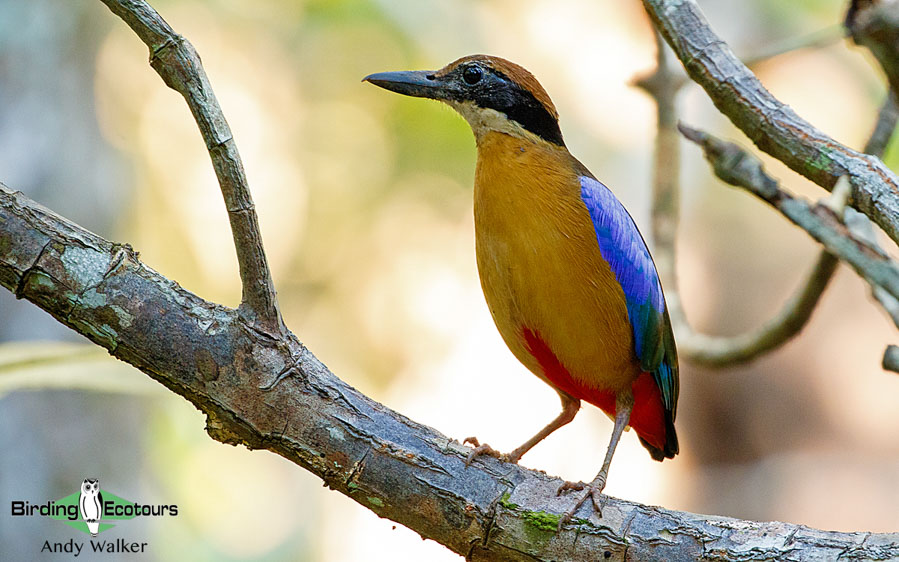
Itinerary (13 days/12 nights)
Day 1. Arrival at Kuala Lumpur
After arrival at Kuala Lumpur International Airport you will be taken to our nearby hotel, with the rest of the day spent at leisure. The group will meet for a welcome dinner in the evening, when we will discuss plans for the coming days.
Overnight: Putrajaya
Day 2. Pulau Indah and Putrajaya
We will have an early-morning transfer to the coastal mangroves for Mangrove Pitta and other species such as Lesser Adjutant, Ashy Tailorbird, Laced Woodpecker, Sunda Pygmy Woodpecker, Pink-necked Green Pigeon, Blue-tailed Bee-eater, Copper-throated Sunbird, Brahminy Kite, White-bellied Sea Eagle, Black-winged Kite, Lesser Coucal, Coppersmith Barbet, Long-tailed Shrike, Barred Eagle-Owl, and more. After the morning birding session we will travel back to our hotel for a rest during the heat of the day and some lunch.
In the late afternoon and early evening we will head out again to a patch of forest, looking for Oriental Dwarf Kingfisher, Blue-eared Kingfisher, Black-and-red Broadbill, Dusky Broadbill, Black-and-yellow Broadbill, Gold-whiskered Barbet, Oriental Dollarbird, Brown Hawk-Owl, and Blyth’s Frogmouth.
Overnight: Putrajaya
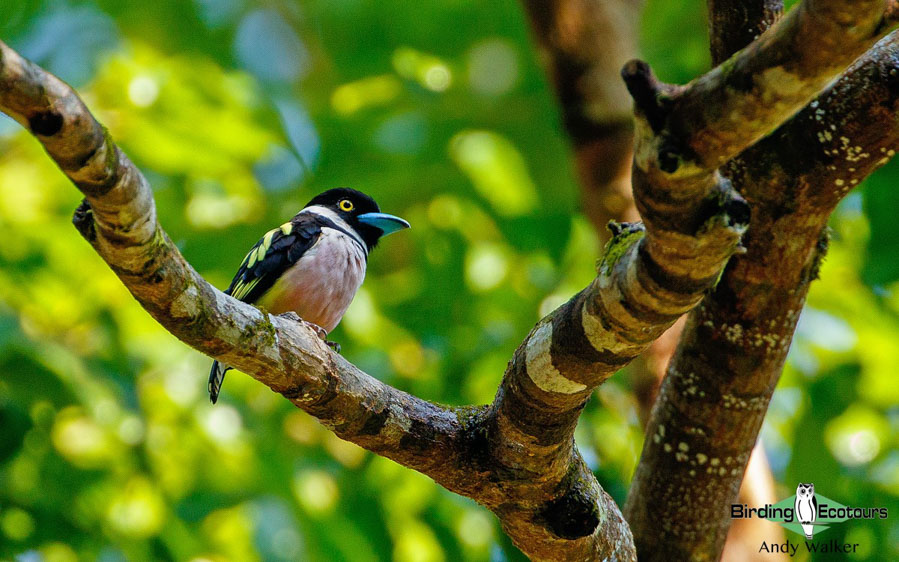
Day 3. Putrajaya
We will likely head back to the same forest that we visited the previous afternoon and evening, where we will look for those listed above and several additional species such as Black-backed Swamphen, Painted Stork, Large-tailed Nightjar, Savanna Nightjar, Plaintive Cuckoo, Rufous-collared Kingfisher, White-crowned Hornbill, Black Hornbill, Little Bronze Cuckoo, Violet Cuckoo, Banded Broadbill, White-chested Babbler, Pale Blue Flycatcher, Rufous-chested Flycatcher, Scarlet-backed Flowerpecker, and Olive-backed Flowerpecker. We will spend the majority of the day birding in this area, as there are numerous high-quality target birds for us to search for.
Overnight: Putrajaya
Day 4. Kuala Selangor
After breakfast we will visit a nearby heronry for Painted Stork, Purple Heron, Grey Heron, Black-crowned Night Heron, Little Egret, Eastern Cattle Egret, Striated Heron, White-throated Kingfisher, Pied Triller, and others. Then we will check out of our hotel and travel to Kuala Selangor in the afternoon. Along the route we will stop at some rice paddies, where we may find Scaly-breasted, White-headed, Chestnut (Black-headed), and White-rumped Munias, White-breasted Woodswallow, Yellow Bittern, Cinnamon Bittern, Watercock, Oriental Pied Hornbill, Coppersmith Barbet, and others. At night we will be looking for Buffy Fish Owl, Sunda Scops Owl, Spotted Wood Owl, and Large-tailed Nightjar.
Overnight: Kuala Selangor
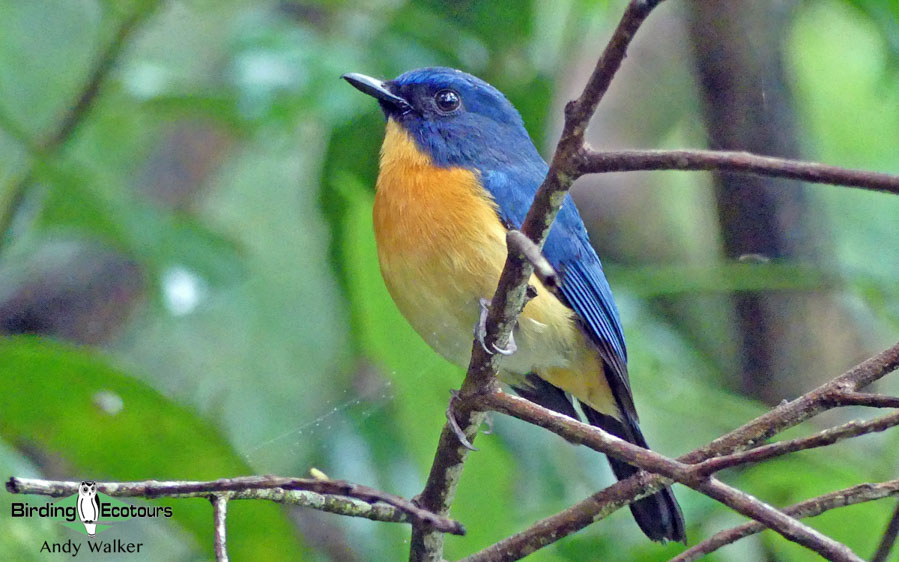
Day 5. Kuala Selangor to Fraser’s Hill
A pre-dawn walk will give us another chance to look for nocturnal species. In the morning we will be exploring the mangroves and their surroundings for Mangrove Blue Flycatcher, Mangrove Whistler, Ruby-cheeked Sunbird, Golden-bellied Gerygone, Little Bronze Cuckoo, Scarlet-backed Flowerpecker, Lineated Barbet, Daurian (Purple-backed) Starling, Crested Goshawk, Crested Serpent Eagle, Red-whiskered Bulbul, Olive-winged Bulbul, Common Flameback, Greater Flameback, and many more.
During the afternoon we will transfer to the beautiful, picturesque mountains of Fraser’s Hill. Along the way to the hill station we will make several stops for Chestnut-naped Forktail, Whiskered Treeswift, Rufous-bellied Swallow, House Swift, Red-wattled Lapwing, and Banded Bay Cuckoo. At night during our time at Fraser’s Hill we will be looking for Brown Wood Owl, Mountain Scops Owl, and Grey Nightjar.
Overnight: Fraser’s Hill
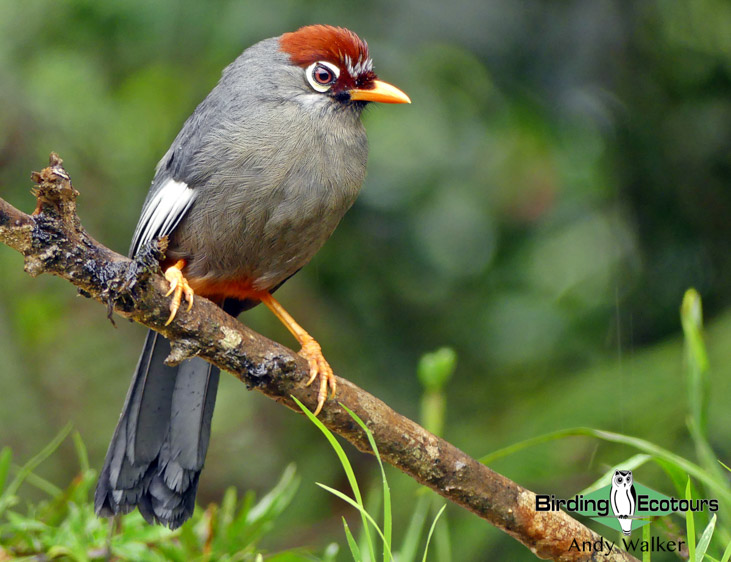
Days 6 – 7. Two full days birding at Fraser’s Hill
We will spend two full days birding at Fraser’s Hill, where there are a number of forest trails, several stakeout sites, and some nice quiet mountain roads to walk along. We will also look for a range of interesting nocturnal birds in the evening (as mentioned for day 5). We will target the endemic Malayan Whistling Thrush, which will require a pre-dawn start and will then lead into the dawn chorus, where we will pick up numerous new birds such as Large Niltava, Slaty-backed Forktail, Streaked Wren-Babbler, and many more. We will also look for a couple of other important targets, namely the near-endemic pair of Malayan Partridge and Malayan Laughingthrush, and the tough, secretive, and subtly beautiful Rusty-naped Pitta.
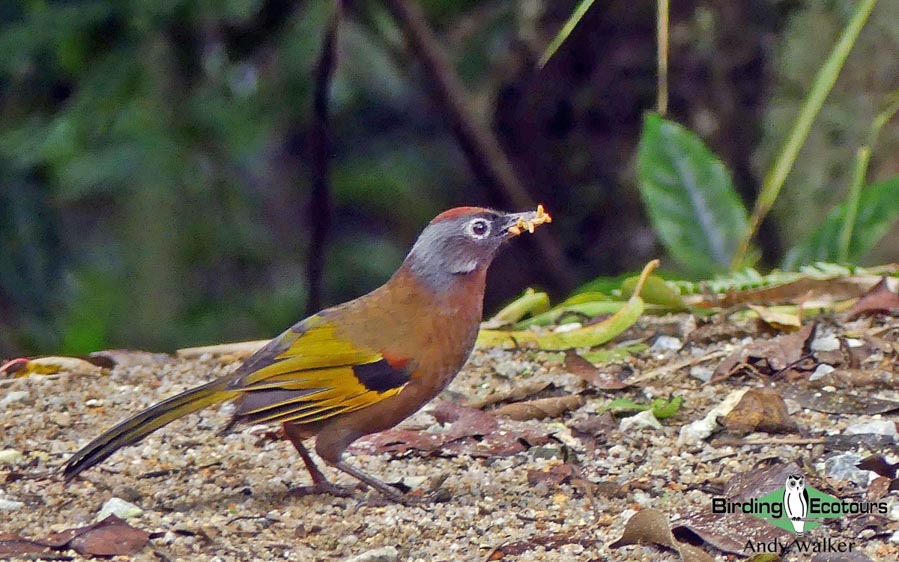
Some of the species we will aim to see at stakeouts along the forest edge and in our hotel grounds include Fire-tufted Barbet, Silver-eared Mesia, Chestnut-capped Laughingthrush, Long-tailed Sibia, Grey-throated Babbler, Little Pied Flycatcher, Rufous-browed Flycatcher, Pygmy Cupwing (formerly Pygmy Wren-babbler), Streaked Spiderhunter, Black-throated Sunbird, White-tailed Robin, and Lesser Shortwing.
Walking through the forest trails at a range of elevations at Fraser’s Hill we will search for the following great species: Black Laughingthrush, Greater Yellownape, Lesser Yellownape, Bay Woodpecker, Large Hawk-Cuckoo, Mountain Bulbul, Ochraceous Bulbul, Scaly-breasted Bulbul, Cinereous Bulbul, Blue Nuthatch (one of the, if not the, best-looking nuthatches on the planet!), Velvet-fronted Nuthatch, Square-tailed Drongo-Cuckoo, Banded Broadbill, Long-tailed Broadbill, Silver-breasted Broadbill, Red-headed Trogon, Orange-breasted Trogon, Chestnut-backed Scimitar Babbler, Buff-breasted Babbler, Golden Babbler, Blyth’s Shrike-babbler, Black-eared Shrike-babbler, Verditer Flycatcher, Mugimaki Flycatcher, Hill Blue Flycatcher, Fire-breasted Flowerpecker, and the stunning Red-bearded Bee-eater.
Overnight: Fraser’s Hill
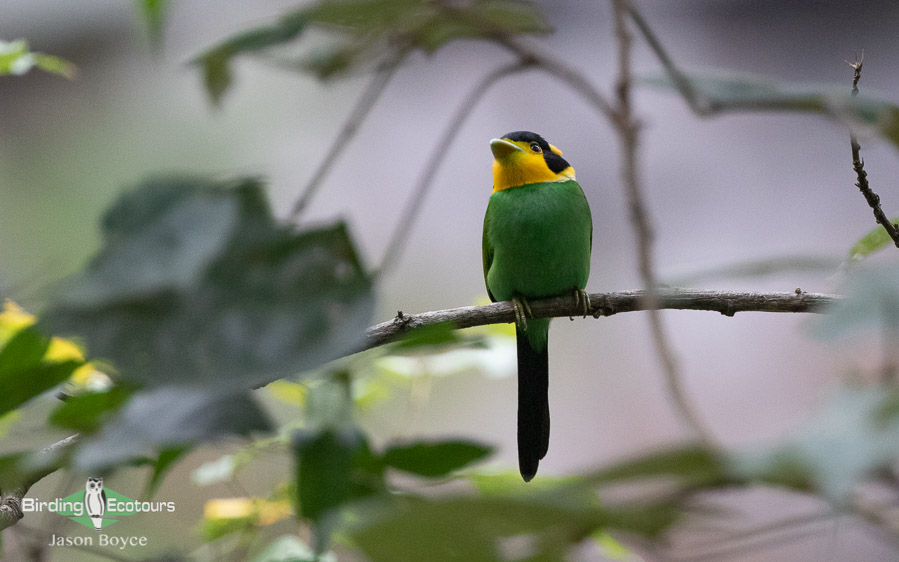
Day 8. Fraser’s Hill to Taman Negara
In the morning we will transfer to the Taman Negara area with a stopover for Dusky Crag Martin, Black Hornbill, Oriental Pied Hornbill, Rufescent Prinia, Banded Broadbill, and others. Upon arrival at Taman Negara village we will start exploring the area for Barred Buttonquail, Blue-crowned Hanging Parrot, Blue-rumped Parrot, Black-and-red Broadbill, Banded Woodpecker, Checker-throated Woodpecker, Asian Palm Swift, Black-thighed Falconet, Oriental Dollarbird, and Rufous-collared Kingfisher.
We will also take a drive around local roads at night (and over the next few nights in the national park too), looking for an assortment of owls, frogmouths, and nightjars such as Sunda Scops Owl, White-fronted Scops Owl, Reddish Scops Owl, Large Frogmouth, Gould’s Frogmouth, Blyth’s Frogmouth, Malaysian Eared Nightjar, Large-tailed Nightjar, Eastern Barn Owl, Buffy Fish Owl, and Oriental Bay Owl.
Overnight: Taman Negara
Days 9 – 11. Three full days birding at Taman Negara
We will have three full days birding within the Taman Negara area, where we will enjoy some absolutely incredible birds. Our first morning will be just outside the national park, where we will look for Rhinoceros Hornbill, Wreathed Hornbill, Great Hornbill, and others.
In the afternoon of day 9 we will transfer across the river into the national park for a three-night stay inside Taman Negara National Park, exploring the forest along the boardwalks/trails and by boat. A couple of the best target birds might include the monotypic Rail-Babbler, the near-endemic Malayan Peacock-Pheasant, and Malayan Banded Pitta, with the possibilities of the Critically Endangered (IUCN) pair of Helmeted Hornbill and Straw-headed Bulbul too. Trogons are well represented in Taman Negara, with the colorful quartet of Scarlet-rumped Trogon, Diard’s Trogon, Red-naped Trogon, and Cinnamon-rumped Trogon all possible.
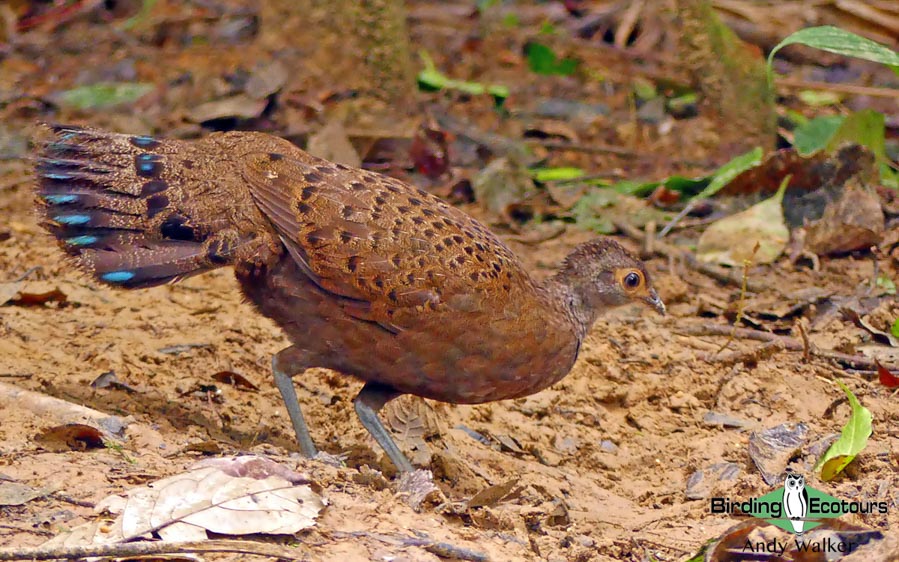
Our birding sessions within the national park will give us ample opportunities for numerous amazing birds. In addition to those outlined above we will also seek out Great Argus, Crested Partridge, Crested Fireback, Garnet Pitta, Crested Jay, Black Magpie, Asian Fairy Bluebird, Black-and-yellow Broadbill, Green Broadbill, Great Slaty Woodpecker, White-bellied Woodpecker, Buff-rumped Woodpecker, Buff-necked Woodpecker, Indochinese Blue Flycatcher, Malaysian Blue Flycatcher, Blue-banded Kingfisher, Oriental Dwarf Kingfisher, Ruddy Kingfisher, Stork-billed Kingfisher, Blue-eared Kingfisher, Banded Kingfisher, Rufous-collared Kingfisher, and Red-bearded Bee-eater, plus plenty more hornbills, orioles, malkohas, and pigeons (Jambu Fruit Dove is a stunner!).
Not as colorful maybe as the above-mentioned species, but the forest is also home to a wide range of (often skulking) restricted-range bulbuls and babblers, such as Yellow-bellied Bulbul, Grey-cheeked Bulbul, Hairy-backed Bulbul, Black-and-white Bulbul, Large Wren-Babbler, Striped Wren-Babbler, Chestnut-winged Babbler, Chestnut-rumped Babbler, White-chested Babbler, Sooty-capped Babbler, Moustached Babbler, Black-capped Babbler, Black-throated Babbler, Fluffy-backed Tit-Babbler, and so much more!
Forest raptors possible during our time here include Blyth’s Hawk Eagle, Bat Hawk, Rufous-bellied Hawk, Changeable Hawk-Eagle, and Black Eagle, so we will need to keep an eye to the sky while in forest clearings.
Regardless of what we find, we are certain to see some of the best birds in all of Asia over these few days, and it is an amazing habitat to be in. Some interesting mammals could be on the cards too, such as Malay Tapir, Greater Slow Loris, Siamang, and Lar (White-handed) Gibbon.
Overnight: Taman Negara
Day 12. Taman Negara to Bukit Tinggi
We will have a final morning birding at Taman Negara, looking for anything else that might be new or missing from the species listed above before we drive to Bukit Tinggi in the afternoon.
Overnight: Bukit Tinggi
Day 13. Bukit Tinggi to Kuala Lumpur International Airport, tour concludes
We will have an early morning birding session, where we will target the rare and localized endemic Mountain Peacock-Pheasant as well as the tough Ferruginous Partridge. There are plenty of other exciting birds in this gorgeous forest, and we may also find Sultan Tit, Large Woodshrike, Long-billed Spiderhunter, Blue-winged Leafbird, and Chestnut-backed Scimitar Babbler. After lunch we will transfer back to Kuala Lumpur, where the tour will conclude mid-afternoon and you will be able to take your evening international flight home.
Overnight: Not included
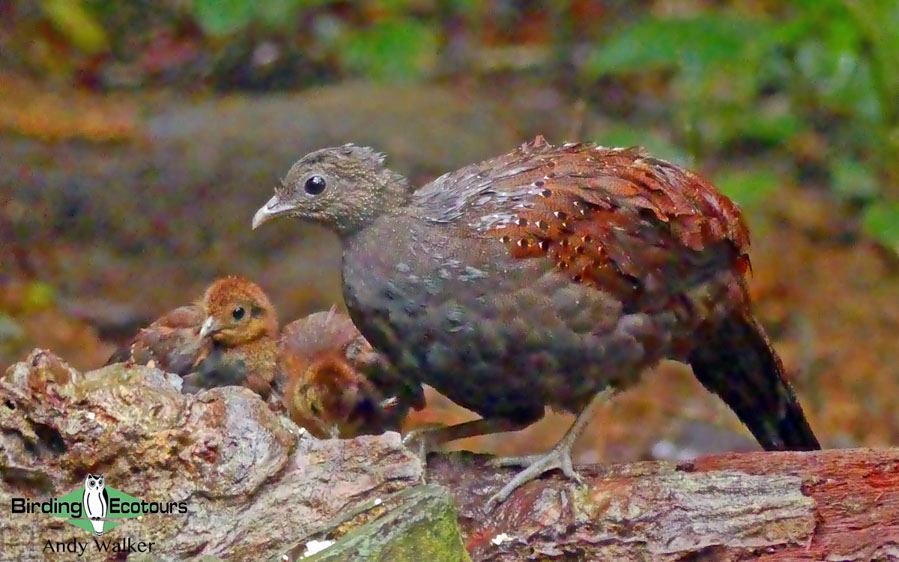
Please note that the itinerary cannot be guaranteed as it is only a rough guide and can be changed (usually slightly) due to factors such as availability of accommodation, updated information on the state of accommodation, roads, or birding sites, the discretion of the guides and other factors. In addition, we sometimes have to use a different international guide from the one advertised due to tour scheduling.
Download ItineraryPeninsular Malaysia Trip Report
07 – 18 JANUARY 2018
By Andy Walker
DOWNLOAD TRIP REPORT
This customized tour commenced in Kuala Lumpur on 7th January 2018 and concluded back there on the 18th January 2018. The tour followed our set-departure route and covered several key birding sites in Peninsular Malaysia, visiting various habitats from coastal mangrove forests up to the highlands of the Titiwangsa range, which runs southward from the border of Thailand and forms the backbone of the peninsula. We also concentrated effort on the world famous and stunningly bird-rich Taman Negara National Park. The tropical rainforest here is said to be 130 million years old, and it is a spectacular sight full of a huge array of wildlife. We targeted many of the highly-sought species to be found in Malaysia, such as pittas, trogons, broadbills, hornbills, and kingfishers, as well as three difficult and localized Malaysian endemics (a partridge, a peacock-pheasant, and a whistling thrush).
The tour connected with many exciting birds, such as Crested Fireback, Malaysian and Ferruginous Partridges, Mountain and Malaysian Peacock-Pheasants, Great Argus, Lesser Adjutant, Black Baza, Black-thighed Falconet, Blyth’s Hawk-Eagle, Helmeted, Wreathed, Black, Oriental Pied, and Rhinoceros Hornbills, Speckled and Rufous Piculets, Great Slaty and Orange-backed Woodpeckers, Buffy Fish Owl, Mangrove, Blue-winged, and Hooded Pittas, Stork-billed, Banded, and Rufous-collared Kingfishers, Diard’s, Scarlet-rumped, Red-headed and Orange-breasted Trogons, Green, Black-and-red, Black-and-yellow, Dusky, and Silver-breasted Broadbills, Crested Jay (Shrikejay), Black Magpie, Mangrove Blue Flycatcher, Mangrove Whistler, Malayan Whistling Thrush, Straw-headed and Black-and-white Bulbuls, Malayan Laughingthrush, and Silver-eared Mesia.
A total of 309 bird species were recorded (286 seen), along with an impressive list of other animals, including Silvered and Dusky Leaf Monkeys, Pale-thighed Langur, Siamang, and Lar Gibbon, as well as a range of beautiful butterflies, including the incredible Rajah Brooke’s Birdwing. Species lists are at the end of this report.
Peninsular Malaysia Tour:
Day 0, 6th January 2018. Pre-tour arrival into Kuala Lumpur
Paul and Ken arrived during the morning and met up with Birding Ecotours leader Andy Walker and local guide Weng Chun. The afternoon was spent at leisure.
Day 1, 7th January 2018. Kuala Lumpur area
After an early breakfast we headed out to a forest not too far from Kuala Lumpur. Our first stop of the day yielded Buff-rumped Woodpecker, Raffles’s Malkoha, Brown Shrike, Crested Goshawk, and Chestnut-winged Babbler along with several more common species such as Common Tailorbird, Blue-tailed Bee-eater, Germain’s Swiftlet, and Grey-rumped Treeswift. Black-and-yellow Broadbill was calling but remained deep in the forest. It was Sunday morning, so there were many locals out and about taking their morning exercise, so we decided to head off to a quieter area and were duly rewarded for doing so.
We staked out a small stream in the hope that we might see Oriental Dwarf Kingfisher, but, unfortunately, although we heard one fly past, it didn’t stop and sit for us. While waiting here we did get to watch some interesting behavior from a pair of White-chested Babblers that were catching small fish! We were also visited by a pair of tiny Rufous-chested Flycatchers, and as the morning progressed a number of interesting birds came in and showed well. The picks of these birds included Black Magpie, Dusky Broadbill, Rufous Piculet, Checker-throated, Crimson-winged, Buff-rumped, and Maroon Woodpeckers, a stunning male Yellow-rumped Flycatcher, Greater Racket-tailed Drongo, Little Spiderhunter, Purple-naped Sunbird, Golden-whiskered Barbet, and Chestnut-breasted Malkoha.
The afternoon was very hot, and activity slowed down a fair bit, although a walk along a river gave us a few new birds, most prized of these were the views we had of a male Rufous-collared Kingfisher, a really pretty bird. We also found a male Mugimaki Flycatcher, Blue-winged Leafbird, Eastern Crowned and Arctic Warblers, and Pin-striped Tit-Babbler.
Our final roadside stop of the day before we drove back to our hotel gave us some good, close views of Black-thighed Falconet and flyovers of Lesser Fish Eagle and Blue-crowned Hanging Parrot – a decent end to a great first days birding in the country.
Day 2, 8th January 2018. Shah Alam area
After an early breakfast we left our base at Putrajaya for the Shah Alam area. We drove through some fairly heavy rain showers, but luckily our birding stops managed to dodge these. The typical common birds were noted as we drove to our birding site, such as Blue-tailed Bee-eater, Oriental Dollarbird, White-throated Kingfisher, and Pink-necked Green Pigeon – a very colorful mix of birds. Our first stop in some mangroves gave us our first Laced Woodpecker of the trip, and then we hit a small tidal waterbody, where we found many exciting species such as Collared, Common and Stork-billed Kingfishers, Sunda Pygmy Woodpecker, Common Flameback, hundreds of Barn and Pacific Swallows, Peregrine Falcon, Ashy Tailorbird, Yellow-bellied Prinia, Golden-bellied Gerygone and the stunning Copper-throated Sunbird. Here we also saw our first Silvered Leaf Monkeys and Long-tailed Macaques.
Leaving this area for our next birding spot we found Black-winged Kite, Brahminy Kite, Greater and Lesser Coucals, hundreds of Spotted and Zebra Doves, Scaly-breasted Munia, Paddyfield Pipit, and Red-wattled Lapwing. We then spent an hour or so focusing on one of our main trip targets, and eventually we all saw at least one of the two, simply stunning, Mangrove Pittas that were giving tantalizing views but eventually showed fairly well. These birds just glow in the dark mangrove forests. After enjoying these we started to look at some of the other birds around the mangroves, adding three Little Bronze Cuckoos, many Germain’s Swiftlets, Long-tailed Shrike, and best of all a pair of Lesser Adjutants. These humungous storks were elegantly walking through an area of grassland.
After checking into our hotel in Shah Alam after lunch we sat out the heat of the middle of the day. The afternoon birding session was fairly quiet in terms of number of species, but we did pick up a few new birds such as Forest Wagtail, Black-winged Flycatcher-shrike, Crested Serpent Eagle, Asian Brown Flycatcher, and good views of a perched Crested Goshawk too.
Day 3, 9th January 2018. Shah Alam area and Kuala Selangor
We awoke to a huge thunderstorm that lasted a couple of hours, so we took a relaxed breakfast and enjoyed the plentiful food and drink that was on offer. As the rain eased off we headed towards some parkland, where between frequent showers we picked off several rather nice birds.
The main target birds of the morning were Blue-winged and Hooded Pittas. Blue-winged Pitta popped into view nicely and quickly, getting to its favored area; however, Hooded Pitta was less obliging. It was heard calling a couple of times, with only Paul getting brief but very good views. There were plenty of other birds here too. A gorgeous Banded Woodpecker showed nicely when it dropped down into good light out of the gloom, and a roving flock of Large Woodshrikes were noted. Brown Shrikes were plentiful, and there were numerous Blue-crowned Hanging Parrots, which typically mainly were flyovers, but a couple were seen to land briefly. We got fantastic looks at Pink-necked Green Pigeon foraging in a fruiting tree, along with Common Iora, Asian Glossy Starling, and both Yellow-eared and Spectacled Spiderhunters. Several Blue-throated Bee-eaters made a change from the Blue-tailed Bee-eaters we’d seen plenty of during the last couple of days (though later in the day we also saw plenty of the latter too). Other species noted at the site included Sooty Barbet, Green-backed Flycatcher, and Black-naped Oriole.
We headed back to the hotel for lunch, took a late check-out, and then drove an hour or so up the coast to our new hotel at Kuala Selangor, spotting a Lesser Adjutant flying along the road on the way. A brief stop near the lighthouse at Kuala Selangor produced Coppersmith and Lineated Barbets, Red-whiskered Bulbul, another Lesser Adjutant, a couple of flyovers from the same Black Baza, and spectacularly low overhead displaying from a pair of White-bellied Sea Eagles.
After checking into our hotel for the night we took a quick walk along a mangrove-lined channel, where we eventually saw Black-capped and Collared Kingfishers, had a brief glimpse of a vocal Greater Flameback on one side of the channel while two Common Flamebacks sat in a tree on the opposite side, and saw a small flock of Whiskered and Little Terns. It was, however, rather hot and quite quiet, but Oriental White-eye and Golden-bellied Gerygone were also noted. We then went to a Chinese fish restaurant along the river, where we enjoyed a very nice meal and followed it up with a bit of night-birding, where we saw a couple of Large-tailed Nightjars, heard a Sunda Scops Owl, and saw the huge Buffy Fish Owl. A great way to end another really enjoyable day!
Day 4, 10th January 2018. Kuala Selangor
We took a morning walk around the Kuala Selangor Nature Park, an interesting mix of forest and mangroves. As we entered the forested area a flock of a dozen or so Ashy Minivets flew through, some stopping long enough for good views. The first new bird of the day was one of our main targets of the morning, the gorgeous Mangrove Blue Flycatcher. This bird showed very well and was certainly making the most of the plethora of mosquitoes that were about. After enjoying watching this bird we continued around the park, picking up Coppersmith Barbet, Malaysian Pied Fantail, Ashy Tailorbird, Laced Woodpecker, Little Bronze Cuckoo, and over a dozen Black Bazas.
As we entered the mangrove forest section of the park we picked up several different birds, including the rather plain but geographically interesting Mangrove Whistler along with the similarly interesting Golden-bellied Gerygone. After the brief fly-through the previous day by a Greater Flameback we got some cracking close-up views of a male that showed incredibly well. Cinereous Tit too also showed well, as did Ashy Drongo, Pied Triller, Malaysian Pied Fantail, Oriental White-eye, and numerous Collared Kingfishers.
As we left the mangroves for some more open areas on our way out of the park we noted Yellow-bellied Prinia, Ashy Tailorbird, and a couple of Brown Shrikes. The sky was full of the calls of three Crested Serpent Eagles along with several Brahminy Kites, a pair of White-bellied Sea Eagles, and both Edible-nest and Germain’s Swiftlets.
Back at our hotel we packed our bags, enjoyed a local lunch, and then commenced our journey from the sweltering lowlands to the much cooler Fraser’s Hill. The drive took a couple of hours, most of it through heavy rain. We made two stops along the way, one for House Swifts, the other for a small flock of the beautiful Whiskered Treeswift. We also saw several new primates along the drive, such as Pig-tailed Macaque, Pale-thighed Langur, and Siamang.
Once we arrived at the top of the mountain we stopped at an area to look for one of our main target birds of the area, the endemic Malaysian Partridge. Despite hearing one call they didn’t show, but we did have excellent views of Malayan and Chestnut-capped Laughingthrushes and Spectacled Spiderhunter before it got dark, also finding a flock of Long-tailed Sibia visiting the bird tables at our hotel.
We had a wonderful dinner at the local Chinese restaurant and then, despite the cloud dropping down and covering most of the hill, took a short night drive. We had great views of Grey Nightjar and Brown Wood Owl as well as hearing a couple of distant Mountain Scops Owls. However, equally impressive was the giant Atlas Moth that flew in to check us out.
Day 5, 11th January 2018. Fraser’s Hill
We made an early start to look for one of the most difficult endemics in Peninsular Malaysia, Malayan Whistling Thrush. Unfortunately, despite hearing the high pitch call of one in the valley below us, it failed to show. As it started to get light enough to see properly we started picking up new birds. Fire-tufted Barbet is one spectacular bird, and a close-up view was fantastic. But it was suddenly bettered when a squirrel started alarm-calling and we turned around to find a Blyth’s Hawk-Eagle sitting right behind us. A very lucky encounter! Several Little Cuckoo-Doves and Mountain Imperial Pigeons flew through from their roosting sites, along with several Pacific Swifts. A male Black-and-crimson Oriole flew in and landed at the top of a tree and was joined by several Grey-chinned Minivets, while nearby there was a flock of Mountain Fulvetta with a lone Golden Babbler, White-throated Fantail, and a couple of Mountain Bulbuls.
After breakfast back at our hotel we took a drive around the local area. It started raining, at times quite heavily, and unfortunately continued through the morning. Despite the poor weather we persisted, making good use of our vehicle and the various shelters dotted around. We were successful in finding many great birds over the course of the day and got some fantastic views of most, such as Pygmy Wren-babbler, Grey-throated Babbler, Large Niltava, White-throated Fantail, Lesser Racket-tailed Drongo, White-tailed Robin, Rufous-browed Flycatcher, Mugimaki Flycatcher, Long-tailed Sibia, Chestnut-capped Laughingthrush, Everett’s White-eye, and the gorgeous Silver-eared Mesia. The final bird we saw before we headed back to our hotel for lunch was the endemic we’d been looking for the previous evening, Malaysian Partridge. One was very nervous and spent most of the time hidden, but we all got views of the bird.
Unfortunately, there was no let up in the rain all afternoon, and we struggled to see many species that we hadn’t seen earlier in the day, like Verditer Flycatcher, Large Cuckooshrike (formerly considered a subspecies of the Javan Cuckooshrike complex), Sultan Tit, Grey Wagtail, and Malayan Laughingthrush.
Day 6, 12th January 2018. Fraser’s Hill
Another early start saw us back at the same stakeout as the previous morning, and it was still raining. After sitting in the dark for 20 minutes our target bird started calling and gradually came closer. We waited to see if it would come into view. Unfortunately, and frustratingly, the Malayan Whistling Thrush chose to walk into the only part of our view that only Andy could see, before it decided to turn around and walk back the way it came, and there was no further sign of it as it called further and further down the valley. We headed back to the hotel for breakfast, where we had Yellow-browed Warbler and Blue-winged Minla in the parking lot.
Due to the continued heavy rain and poor visibility we decided to drop down in altitude on the mountain to an area known as ‘The Gap’ in hopes that the weather conditions would be better a bit lower. As we drove down the slope we hit a very rapidly moving bird wave (mixed flock). It was hard to get on the majority of birds, but we did find Hill Blue Flycatcher, Lesser Racket-tailed Drongo, White-bellied Erpornis, Grey-chinned Minivet, and Ochraceous Bulbul. Further down still, and we found White-rumped Shama, Black-crested and Cinereous Bulbuls, Golden-whiskered and Black-browed Barbets, Bar-winged Flycatcher-shrike, and Asian Fairy-bluebird. We thought we had escaped the poor weather, but it soon caught up with us, so we made a hasty retreat even further down the mountain.
Chestnut-capped Laughingthrush is one of several beautiful laughingthrushes enjoyed on the tour.
On getting to ‘The Gap’ we found a covered area to sit under; it was still raining. As luck would have it we parked next to a fruiting tree; all we needed was for the cloud to lift again and the rain to ease. We sat it out for a couple of hours and had bouts of dry weather, but not much. During these better periods we saw some great birds, such as Red-headed Trogon, Black Laughingthrush, Orange-bellied and Blue-winged Leafbirds, Little Spiderhunter, Black-throated Sunbird, Stripe-throated, Ochraceous, and Black-crested Bulbuls, Orange-bellied Flowerpecker, Greater Racket-tailed Drongo, and Green-billed Malkoha. We also had an interesting time working through the flock of swifts and hirundines that were present despite the rain, and we identified Edible-nest, Black-nest, and Plume-toed Swiftlets, House Swift, Barn Swallow and Asian House Martin.
It came time to head back up the mountain. There was no sign of a let-up of the poor weather, as would be the theme for the whole afternoon. We saw a few good birds on our drive, such as a stunning male Mugimaki Flycatcher, Golden Babbler, Mountain Tailorbird, and White-throated Fantail. The late afternoon was pretty much a write-off due to continued heavy rain; it just wasn’t safe to be out, as evidenced by several fresh tree falling over the road, including one that almost did us some damage. Sometimes it pays to look at monkeys! We did hear Greater Yellownape but had zero chance of seeing it, so we enjoyed a cold beer, ate a nice dinner, and hoped for better weather and luck over the coming days.
Day 7, 13th January 2018. Fraser’s Hill to Taman Negara
We awoke to find that the rain had finally almost stopped; it was much lighter. We again went to our Malayan Whistling Thrush stakeout and were again rather unfortunate. The bird was seen flying through but landed out of sight before continuing down the valley and out of range. Evidently a very tricky bird to see well! After breakfast we spent some time birding around the roads near our hotel, but most of what we saw were repeats of the birds seen the previous days, although a pair of Little Pied Flycatchers were very nice near a familiar tree fall, as was a very vocal Lesser Shortwing.
When the weather started taking a turn for the worse we started off down the mountain toward Taman Negara. We took our time along the exit road and bumped into a couple of nice mixed flocks, in which we found Scaly-breasted, Mountain, Cinereous and Black-crested Bulbuls, Speckled Piculet, Everett’s White-eye, Verditer, Taiga, Asian Brown, and Mugimaki Flycatchers, Fire-breasted and Orange-bellied Flowerpeckers, Eastern Crowned, Chestnut-crowned, and Yellow-browed Warblers, and Grey-chinned Minivet. A pair of Wreathed Hornbills gave fantastic perched and flyover views a couple of times, as did a Blyth’s Hawk-Eagle and an Orange-breasted Trogon. As we were driving past a river a large, dark thrush was spotted on the side of the road; it was the mythical Malayan Whistling Thrush! Everybody except Paul saw it, which was incredibly unfortunate, as it was all down to luck, when we came around a corner in the road, as to who could see it before it flushed. Despite all our best efforts it could not be relocated.
As we left the mountain to continue our journey we spotted a few nice birds that we made stops for, such as Changeable Hawk-Eagle, Crested Serpent Eagle, and Whiskered and Grey-rumped Treeswifts. After a late lunch stop we came into an interesting site where we found Rufous-bellied Swallow, Dusky Crag Martin, Peregrine Falcon, and, best of all, a stunning male Banded Kingfisher. What a beautiful bird!
As we neared Taman Negara and our accommodation for the night a brief roadside stop yielded a pair of Red-bearded Bee-eaters, plenty of low-level Grey-rumped Treeswifts, and a Silver-rumped Spinetail, while the sound of a male Great Argus rang out around the mountainside. A little further along the road we found a Brown-backed Needletail, our tenth species of swift for the day!
After a quick dinner and checklist session we took a night drive near the village. Over the course of an hour or so we heard Large Frogmouth and saw two Large-tailed Nightjars, Eastern Barn Owl, and Buffy Fish Owl. An enjoyable end to a long day.
Day 8, 14th January 2018. Taman Negara
Unsurprisingly, it was still raining in the morning, so we took a drive through a nearby forest. Things started off very slowly with a few highlights such as Lesser Fish Eagle, Changeable Hawk-Eagle, and Thick-billed, Large, and Pink-necked Green Pigeons. As we continued we came to a decent mixed flock that kept us entertained over the course of the next hour or so. The flock contained numerous bulbuls of several species, including Black-headed, Streaked, Cinereous, Cream-vented, Asian Red-eyed, Spectacled, Stripe-throated, and Yellow-vented Bulbuls, allowing a great comparison to be made between these species. Other birds in and around this flock included Lesser Cuckooshrike, Black-bellied Malkoha, Little Cuckoo-Dove, Greater Green Leafbird, Asian Fairy-bluebird, Common Hill Myna, and Red-throated Sunbird. Pressing on back to our hotel we found another gathering of birds; these included the bird of the morning, the rare Black-and-white Bulbul, Black-and-red Broadbill, Red-billed Malkoha, Ashy Minivet, Green Iora, and Little Green Pigeon. Here we also had our first sighting of the spectacular Rhinoceros Hornbill, a bit distant, but nevertheless and impressive beast. Black-thighed Falconet and another Changeable Hawk-Eagle were sitting on dead snags atop huge trees, and we then had better looks of another Rhinoceros Hornbill drying out in the top of a bare tree. Swifts of several species were ever-present, often very low and close.
After packing up at the hotel, and after enjoying close, eye-level views of several gorgeous Asian Fairy-bluebirds, two more Black-and-red Broadbills, Brown-backed Needletail, and a Grey-breasted Spiderhunter, we caught a boat to the Mutiara Taman Negara Resort for our next three nights’ stay in the jungle.
A nice buffet lunch was enjoyed while watching a female Great Argus, and after a short rest we headed out into the forest of Taman Negara National Park for the first time. The forest can be a tricky place for birding, but with patience there are plenty of rewards. During our afternoon walk we were rewarded with views of Crested Jay (Shrikejay), Green Broadbill, Scarlet-rumped Trogon, Square-tailed Drongo-Cuckoo, Black-bellied Malkoha, Scaly-crowned, Rufous-crowned and Chestnut-winged Babblers, Red-bearded Bee-eater, and just as it was getting dark a male and two female Crested Firebacks, very impressive pheasants. We also had a stunning Barred Eagle-Owl and Sunda Scops Owl outside our rooms after dinner.
Day 9, 15th January 2018. Taman Negara.
We took a morning boat ride along the river from our lodge, picking out four species of impressive hornbills along the way: Helmeted, Black, Wreathed, and Rhinoceros Hornbills. It was great to see Helmeted Hornbill particularly; over recent years this species has been massively hunted almost out of existence for its casque, It is now considered Critically Endangered by IUCN. We also saw the by now extremely rare Straw-headed Bulbul; again, once common, this beautiful songster has become a firm favorite of the pet trade and its wild population has plummeted dramatically over the last 20 years. It is now classified as Endangered by IUCN. There were plenty of other birds to enjoy on our boat ride, such as Lesser Fish Eagle, Short-toed Coucal, Chestnut-naped Forktail, Stork-billed Kingfisher, Crested Jay (Shrikejay), Dark-throated Oriole, Blue-throated Bee-eater, Ferruginous and White-chested Babblers, Buff-vented and Hairy-backed Bulbuls, Silver-rumped Spinetail, Buff-necked Woodpecker, and numerous Black-and-red Broadbills and Raffles’s Malkohas.
We decided to jump out of the boat and walk the last few hundred meters back to our accommodation, and this turned out to be a good move with several new/interesting birds seen, such as Orange-backed and Crimson-winged Woodpeckers, Green Broadbill (incredible eye-level views), Scarlet-rumped Trogon, Crow-billed Drongo, Rufous-winged Philentoma, and Rufous-crowned, Moustached, Chestnut-rumped, and Chestnut-winged Babblers.
After a light lunch and rest we headed back into the forest for a short walk. It was fairly quiet, but we managed to eke out a few new birds along the way, such as Sooty-capped and Horsfield’s Babblers, Tickell’s Blue Flycatcher, and Tiger Shrike. We also had an impressive foraging flock of Brown-backed Needletail and Pacific Swift, some of them shooting overhead by a matter of meters – a very cool sight and sound!
A short early-evening walk nearly got us a Blyth’s Frogmouth, but it unfortunately remained too far away and out of sight.
Day 10, 16th January 2018. Taman Negara
This was a very hot day with temperatures much higher than those over the last few days, and bird activity was much lower, considered to be a result of this. We took a short pre-dawn walk near our rooms and heard Sunda and White-fronted Scops Owls, but although both birds responded, neither came close enough to see through the thick vegetation they were hiding behind. As we passed our accommodation on our way to breakfast we could hear three Blue-winged Pittas calling from the immediate vicinity of their roosting areas.
After breakfast we headed into the forest and almost immediately were rewarded with the sight of a Malayan Peacock-Pheasant, which showed well. A pair of Yellow-bellied Bulbuls passed through briefly but showed well, as did a Black Magpie. We then hit a small but vocal bird wave (mixed species flock) made up of Chestnut-winged, Moustached, Sooty-capped, and Scaly-crowned Babblers, Rufous-winged Philentoma, and Banded Woodpecker.
On entering another trail we soon caught up with a different mixed flock; the standout bird of this flock was Dark-throated Oriole. We found the odd bird here and there, such as Blue-eared Barbet, Yellow-crowned Barbet, Chestnut-breasted Malkoha, and Black-naped Monarch, but the activity really dropped off and it was quiet for the rest of the day, leaving us to enjoy some spectacular butterflies such as Great Mormon, Yellow Archduke, and Horsfield’s Baron around the lodge grounds.
A short afternoon walk resulted in similar birds to the morning, with the addition of a pair of Puff-backed Bulbuls, Tickell’s Blue Flycatcher, and Great Slaty Woodpecker. A tiny Lesser Oriental Chevrotain was the mammalian highlight.
Day 11, 17th January 2018. Taman Negara to Bukit Tinggi
This was mostly a travel day to get from Taman Negara to our final stop of the tour at Bukit Tinggi. We did some morning birding near Taman Negara, where we got some very nice views of Black-and-yellow Broadbill, Blue-crowned Hanging-Parrot, and Yellow-vented Flowerpecker, along with more looks at Asian Fairy-bluebird, Black-bellied Malkoha, and plenty of more common birds. We also had brief looks at Blue-rumped Parrot and Rufous Woodpecker and some prolonged views of some very beautiful Whiskered Treeswifts.
A forest stop-off after lunch allowed us all to get fantastic views of Hooded Pitta as well as the surprisingly gorgeous Black-throated Babbler, Yellow-bellied and Hairy-backed Bulbuls, and White-rumped Shama. The highlight bird of the day, however, was the stunning male Diard’s Trogon that showed remarkably well in the late afternoon. As the sun was setting a flock of Black Baza flew through all too quickly, but we found a large flock of Oriental Pied Hornbills foraging on termites, which was quite entertaining to watch. Not every day you see hornbills ‘flycatching’.
Day 12, 18th January 2018. Bukit Tinggi to Kuala Lumpur
Fittingly, the final day of the tour started off as a wet one, but luckily it finished raining while we ate breakfast. We headed straight to an area of forest, where we patiently sat and waited. After not much time at all we were rewarded with our last endemic of the tour, the rare and secretive Mountain Peacock-Pheasant, not just the one bird but three! An adult female with two very young chicks entertained us, and it was great to be able to watch them feed. A short while later things got even better when a covey of three Ferruginous Partridges appeared. These are really spectacular birds and really take some beating. After soaking in the amazing views of these two species we moved locations slightly and caught up with a few other species, such as Tiger Shrike, Chestnut-backed Scimitar Babbler, Sooty Barbet, Long-billed Spiderhunter, Large Woodshrike, Blue-winged Leafbird, Plaintive Cuckoo, and Sultan Tit.
After a wonderful Chinese lunch we drove back to Kuala Lumpur. A couple of brief final birding stops on the way produced a few new trip birds such as Crimson-breasted Flowerpecker, Lesser Green Leafbird, Crested Honey Buzzard, Pied Triller, Lesser Whistling Duck, Yellow Bittern, Watercock, Black-backed Swamphen, Baya Weaver, and very good looks at a pair of Green Iora.
With that it was off to the airport, where this very enjoyable tour concluded. A huge thank you must go to Weng Chun for his constant efforts in striving to get us views of so many awesome birds, and a massive thank you also to Ken and Paul for making this trip so enjoyable. I look forward to the next one!
Please see the downloadable PDF above with the full species lists included. This is a sample trip report. Please email us ([email protected]) for more trip reports from this destination.
PENINSULA MALAYSIA
TOUR-SPECIFIC INFORMATION
GENERAL INFORMATION ABOUT MALAYSIA (INCLUDING BORNEO) CAN BE READ HERE
TOUR OUTLINE
Starting and ending in Kuala Lumpur, this Peninsular Malaysia bird tour visits some of the best birding locations in southeast Asia, including world famous Taman Negara National Park. A host of wonderful birds can be found on the tour, including Rail-babbler, Malayan Whistling Thrush, Mountain Peacock-Pheasant, Malayan Peacock-Pheasant, Malayan Laughingthrush, and Malayan Partridge, along with a range of stunning hornbills, kingfishers, broadbills, pittas, and trogons.
DAILY ACTIVITIES, PHYSICAL REQUIREMENTS, AND TOUR PACE
This Malaysian birdwatching tour requires reasonable physical fitness but is not considered too physically demanding (though humidity in the lowlands can make you feel tired). We will spend time birding on easy to moderate trails and roads at a range of elevations and will experience hot and humid conditions in the lowlands and cooler temperatures in the mountains. We will also do some birding from small boats while in Taman Negara National Park.
We will usually have early morning birding sessions with a break during the middle of the day back at our accommodation to escape the heat of the day (less of an issue at higher elevations), with further birding sessions in the afternoon. We will undertake some night walks and drives to look for nocturnal wildlife.
This is a birding focused tour that does offer some photo opportunities, though these are secondary to the actual birding element of the tour.
TRANSPORTATION
We will use airconditioned vehicles on this tour. Roads are generally good and paved, though some mountain roads are a little windy, such as at Fraser’s Hill and Bukit Tinggi.
We will use small, motorized boats for birding along the rivers at Taman Negara National Park as this allows us good access into the forest and better chances of observing certain target birds. We will also use small boats for very short crossings between our resort within the national park and the land outside the national park, where our vehicle will be parked for our time there.
DOMESTIC FLIGHTS
There are no domestic flights required for this tour.
LUGGAGE
Please pack as lightly as possible for this tour. We recommend a medium, soft-sided, and robust duffle bag which is likely to work best for packing in the tour vehicles. A small daypack will be useful for when we go out hiking during the day and for keeping items you’d like to have to hand while we are in the vehicles.
SAFETY
As always, your safety is our paramount concern on this, and all of our tours. Please also refer to our Malaysia general information for further information on this and many other topics. This tour does not go to very remote areas, most areas are well developed nature tourist areas. However, we will be visiting large national parks and wilderness areas within these parks that are home to a wide range of wildlife, some of which are potentially dangerous, such as snakes, spiders, etc. Please refer to the general information for more details.
Potential issues on this tour are trips and falls when on trails, tracks/roads, and getting into or out of the tour vehicles and boats, so extra care should be taken at all times. Sturdy walking shoes and hiking boots are recommended for this tour. A hiking pole or walking stick is compulsory if you are at all unsure on your feet.
There is a low risk of malaria on this tour, but please consult your doctor or local travel clinic for specific advice. We will be spending time birding in areas where mosquitos and other biting insects occur. Insect repellent with a high DEET concentration can be useful for keeping them away and reducing the chance of bites. DEET or citronella insect spray can also keep chiggers and leeches away. Chiggers can lead to Scrub (Bush) Typhus and can be incredibly irritating. Leeches do not spread diseases, but they are rather unnerving and can cause blood loss and are particularly evident in Borneo. “Leech socks” are a useful piece of kit.
WEATHER/CLIMATE
We will be spending time in the lowlands and highlands (around 4,900 feet/1,500 meters) on this tour so we will experience a range of temperatures. While in the lowlands we can expect average daytime highs of around 89 °F (32 °C) and average nighttime lows of 68 °F (20 °C). There is often cloud cover here, resulting in hot and humid, rather oppressive conditions. During our time in the mountains, we can expect more pleasant conditions, it is cooler than the lowlands and we can expect average daytime temperature highs of around 80 °F (27 °C) and average nighttime lows of 63 °F (17 °C), but the temperature may drop to below 59 °F (15 °C) occasionally, with wind chill it can feel cooler, particularly in the early mornings and at night.
Please note that the sun is strong here and care should be taken to remain hydrated and use sun protection. Rain is possible at any time at any location so rain gear and an umbrella will be essential. A dry bag is also recommended for protecting optics, electrical equipment/cameras, and any documents you might have with you, such as passports etc.
ACCOMMODATION
The accommodation on this tour is of a good to very good standard and we will be staying in hotels and nature lodges which all have private facilities. All will have electricity, and most will have Wi-Fi, though in some locations this may be restricted to hotel common spaces such as lobbies and restaurants and might be a bit hit or miss. Most accommodation will have air conditioning, except for in the mountains, where it is not really necessary.
ELECTRICITY
It would be advisable to bring a power bank for charging small personal items like smart phones etc. if you are likely to be using them a lot, such as when we are driving around. We should not have any issues with electricity supply, unless there is an unexpected power cut.
COMMUNICATIONS
There is phone signal across most of the tour route and most accommodation will have Wi-Fi (which may be a bit unreliable in some places). You may be able to purchase a local travel SIM card (such as those from Digi.com or Celcom) on arrival at the airport in Malaysia, or use your own provider on a roaming package (roaming charges are likely to be incurred).
FOOD AND MEALS
There are various food choices on this tour, most food is of a Chinese style, with local Malaysian and Indian food being typical options, with some places offering western menu options. Vegetarian food can be arranged but please let us know of any dietary requirements ahead of the tour. Most local meals are based around chicken or fish with rice and noodles, and mixed vegetables, tempeh, and tofu. Fresh fruit will be available. We suggest you bring your favorite snacks or protein bars to supplement your diet.
MONEY
We will have access to ATMs at many locations on this tour as we will be passing though plenty of towns and cities along the tour route, though for convenience it is often best if you can withdraw cash while at the airport.
WHAT TO BRING: CLOTHING AND OTHER ITEMS
The following is a list of useful items to bring on this birdwatching tour to Malaysia and should be read in conjunction with the general information document, which suggests lots of other important items to bring on the tour.
- Hiking pole or walking stick to help on the tracks and trails. A walking stick is compulsory for anyone who is unsteady walking, as we feel this is a safety issue; we don’t want anyone slipping on the forest trails or anywhere else.
- Torch (flashlight) and/or headlamp, and spare batteries – we will have some nighttime bird/wildlife watching during the tour, where a torch and/or headlamp would be required. On some occasions we will also likely be setting off into the forest for our morning birding sessions when it is still dark, so this is essential kit.
- A day pack for carrying personal supply of water/snacks when out on the trails and for other essential gear when out birding, such as umbrella, waterproofs etc. and for keeping personal items you wish to have on you while in the vehicles.
- High concentration DEET or citronella insect repellant.
- Salt sachets for leech removal.
- Leech socks – essential kit on this tour.
- A small personal first aid kit. See the suggested items from the Centers for Disease Control and Prevention (CDC), here. We will be able to call in at pharmacies at some locations, but not at others, so useful to have some essentials with you.
- Footwear is a matter of personal preference but sturdy shoes as a minimum are required, and hiking boots are probably best, with something a bit more comfortable maybe for time spent in vehicles and around the accommodation.
- Quick-drying clothes are the best for this tour and a good selection of clothing layers are also recommended for time at the higher elevations where temperatures will be lower than in the lowlands (see the “Weather/Climate” section for further information on likely temperatures during the tour).
- Rain jacket (and small umbrella) and a coat/fleece for our time in the mountains.
- A dry bag to keep valuable documents in such as passports, cell phones, wallets etc., as well as cameras if it rains.
- Power bank – useful for charging items.

